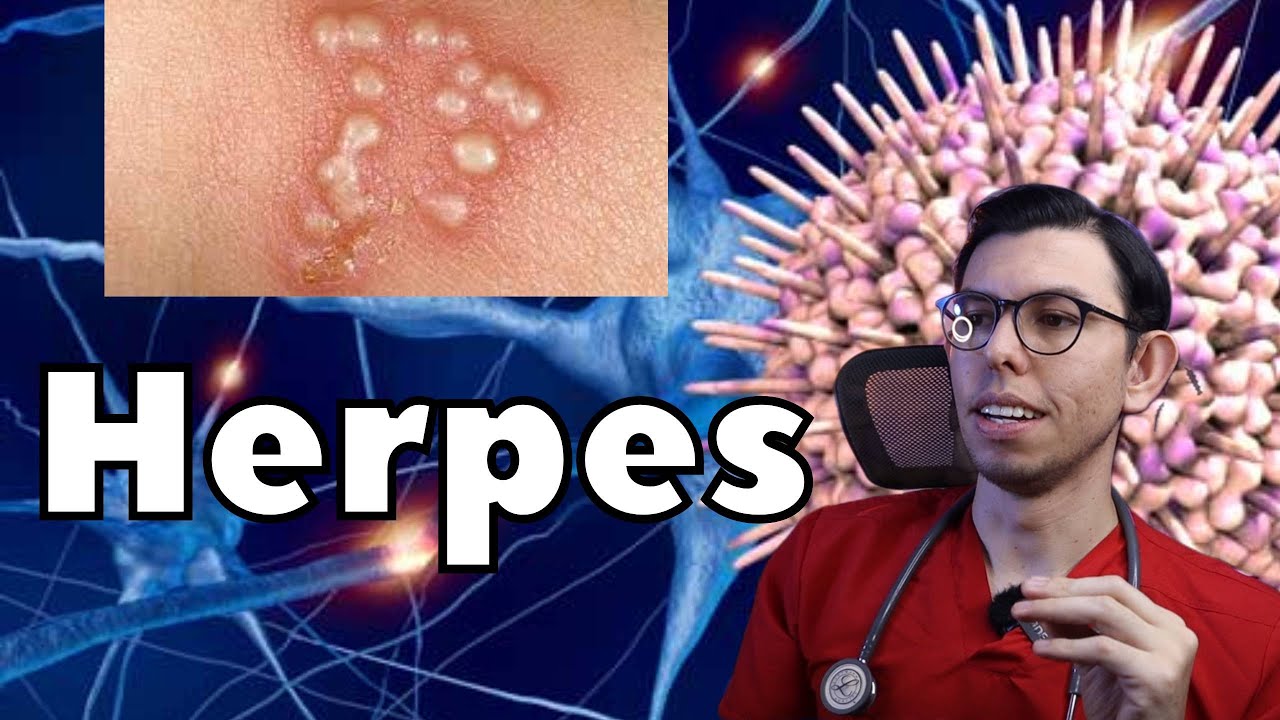Herpes simplex virus replication Steps - Microbiology Animations
Summary
TLDRThe video script discusses the herpes simplex virus (HSV), a DNA virus causing conditions like cold sores and genital herpes. It details the virus's structure, including its double-stranded DNA and icosahedral capsid, surrounded by viral proteins. The script explains the infection process, from binding to host cell receptors to viral replication and assembly. It distinguishes between lytic and latent infections, highlighting the virus's ability to remain dormant in nerve cells for years before reactivating. The video also touches on how stress or immune suppression can trigger viral outbreaks.
Takeaways
- 🧬 Herpes simplex virus (HSV) is a DNA virus that causes conditions like cold sores and genital herpes.
- 🔬 The HSV virion includes a double-stranded DNA chromosome enclosed in an icosahedral capsid.
- 🛡️ The capsid is enveloped by tegument proteins and a host-derived lipid membrane with spike proteins.
- 🔗 The virus can bind to various host cell receptors, leading to the fusion of the viral envelope with the host cell membrane.
- 🚀 After fusion, the capsid is released into the cytoplasm and travels to the nuclear membrane along microtubules.
- ⏳ The tegument protein VHS degrades host cell mRNA, reducing competition for cellular machinery.
- 🛡️ Another tegument protein, VP-16, protects viral mRNA and activates viral gene expression.
- 🔄 The viral DNA circularizes to form a plasmid-like structure within the nucleus.
- 🌀 The virus can follow a lytic infection pathway, leading to the production of new viral particles, or a latent infection pathway, where the virus remains dormant.
- 🧩 In lytic infection, immediate early genes are activated, leading to a cascade of events that result in new virus production.
- 🔄 The viral DNA is replicated using a rolling circle mechanism, and late-stage mRNAs encode for capsid and envelope proteins.
- 🚫 Latent infections can persist in nerve cells for long periods, potentially reactivating under stress or immune system depression.
Q & A
What is an example of a DNA virus mentioned in the script?
-An important example of a DNA virus mentioned in the script is the herpes simplex virus (HSV), which includes strains that cause cold sores and genital herpes.
What is the structure of the herpes simplex virus (HSV)?
-The HSV virion consists of a double-stranded DNA chromosome packed within an icosahedral capsid, which is surrounded by tegument, a collection of about 15 different kinds of virus-encoded proteins.
How does the HSV virion enter the host cell?
-The HSV virion can bind to several alternative receptor molecules in the host cell membrane, after which the envelope fuses with the host membrane, releasing the capsid into the cytoplasm.
What is the role of the tegument protein called 'virion host shut off' (vhs)?
-The vhs protein degrades the host cell's mRNA molecules, eliminating competition for ribosomes and other cellular machinery.
What is the function of the tegument protein vp-16 in the HSV?
-The vp-16 protein protects viral mRNAs and acts as a transcriptional activator of gene expression in the viral genome at a nuclear pore.
How does the herpes chromosome enter the nucleus?
-The herpes chromosome enters the nucleus where it circularizes to form a plasmid-like intermediate.
What is the difference between lytic and latent infections in the context of HSV?
-In a lytic infection, a cascade of events leads to the production of new virus variants, while in a latent infection, latency genes are transcribed to keep the cell from committing suicide and producing new variants.
How does the HSV DNA replicate during a lytic infection?
-The circular viral DNA replicates using a viral DNA polymerase and other proteins, with the production of new genomes for progeny viruses occurring by the rolling circle method.
What are the steps for the assembly and release of new HSV virions?
-The newly synthesized DNA expresses late-stage mRNA, which is translated into capsid and envelope proteins. Capsids form in the nucleus, and the developing virions bud through the nuclear membrane, acquiring an envelope. They move through the endoplasmic reticulum, bud off, and eventually fuse with the Golgi apparatus before budding off and fusing with the plasma membrane to release the completed virions.
Where does the primary infection of HSV occur and what triggers new outbreaks?
-The primary infection occurs in epithelial cells, followed by latent infection within neurons of ganglia near the original site of infection. New outbreaks are often triggered by stress, sunlight exposure, or depression of the immune system.
How does the HSV establish a latent infection, and where does this typically occur?
-The script does not provide a clear mechanism for how a latent infection initiates in neurons, but it is known that a latent infection most commonly occurs in nerve cells.
Outlines

Esta sección está disponible solo para usuarios con suscripción. Por favor, mejora tu plan para acceder a esta parte.
Mejorar ahoraMindmap

Esta sección está disponible solo para usuarios con suscripción. Por favor, mejora tu plan para acceder a esta parte.
Mejorar ahoraKeywords

Esta sección está disponible solo para usuarios con suscripción. Por favor, mejora tu plan para acceder a esta parte.
Mejorar ahoraHighlights

Esta sección está disponible solo para usuarios con suscripción. Por favor, mejora tu plan para acceder a esta parte.
Mejorar ahoraTranscripts

Esta sección está disponible solo para usuarios con suscripción. Por favor, mejora tu plan para acceder a esta parte.
Mejorar ahoraVer Más Videos Relacionados

Herpes Simplex, Causes, Signs and Symptoms, Diagnosis and Treatment.

Genital herpes: Treatment & Management | Stanford Center for Health Education

Why Herpes never goes away | The Institute of Human Anatomy

¡TODO lo que debes conocer sobre HERPES! | Drpologuerrero

How to Destroy HERPES | Dr. Mandell

Virus Herpes Simple. VHS
5.0 / 5 (0 votes)
